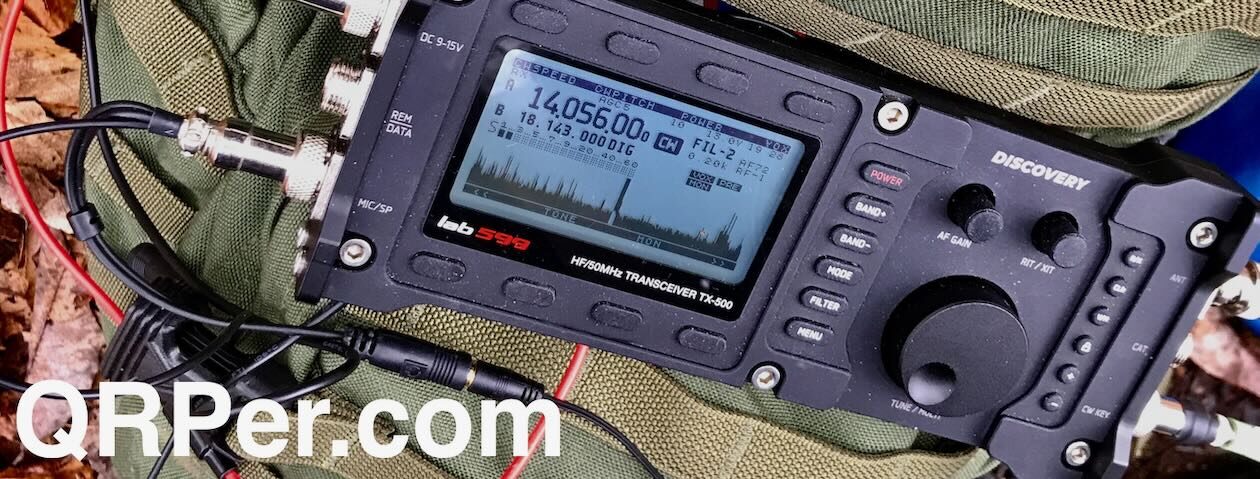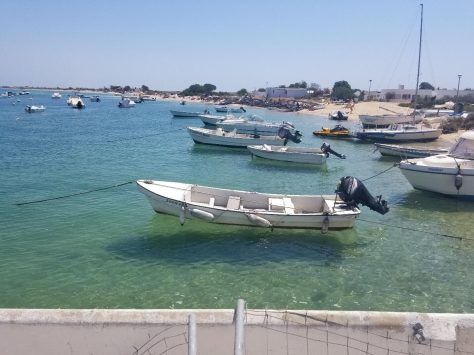Many thanks to Scott (VO1DR) who shares the following guest post:
Construction Notes – VO1DR Antenna Mount for Camera Monopod
by Scott Schillereff, VO1DR
Further to my article about radio during trip to Portugal, a number of readers asked for details on how I mounted my whip antenna system to my camera monopod for /P use. Here are some photos and notes on this.
General notes:
- This is a “straight-through” design. Just direct connections from the BNC center pin to whip (via brass nut), and BNC housing to radial connector.
- This is not a cook-book construction article, rather just a show-and-tell of how I built mine. You can use what you have on hand to build something similar.
- I suggest you start with your telescoping whip, so you know the size and threads for mounting bolt.
- You could use any type of connector for the radial (wingnut, knurled nut, spade lug, alligator clip, whatever you like). I prefer banana jacks since a) I can push in the radial banana plug fast, b) the plug is a weak release point (pulls apart if someone walks into the radial), and c) I can easily attach additional radial wires, if desired.
- Use a strong case (metal clamshell or cast aluminum work well). With the whip extended, there can be substantial forces (bending moment) from wind or handling. A tiny plastic case would be fractionally lighter but might fail.
- For size, the one I used (25 x 25 x 50 mm; 1” x 1” x 2”) is about as small as I would go. It needs to have a big enough footprint to sit firmly on a camera mount fitting.
- Use high heat (e.g., Weller 100-140 W solder gun) when soldering the center pin wire to the brass whip mounting nut. Solder the wire to the brass nut before you epoxy the nut.
- I custom made the white plastic insulating bushing (where whip screws in). This was from a nearly-right bit from my junk box. You can be creative here. You could also epoxy on short piece of close-fitting, thick-walled PVC pipe around the outside of the whip mounting hole as a supporting sleeve to give some lateral support to whip when it is screwed in.
- Dry-fit everything (before epoxying) to make sure nothing touches that shouldn’t and you can screw in the camera nut and whip fine. Test proper continuity of center pin and radial connections to BNC fitting. Once glued, there’s no going back!
- For surfaces to be epoxied (metal nut sides and bottom, insides of mounting case), slightly roughen with sandpaper or jewellers file, then clean with isopropyl alcohol and Q-tip. This will increase adhesion and strength.
- Use good-quality, high-strength, long-cure epoxy (e.g., JB Weld), not el-cheapo 5-minute epoxy from the Dollar Store. LET THE EPOXY COMPLETELY CURE BEFORE MESSING WITH IT! Just walk away from it for a day… (your patience will be rewarded).
 Figure 1 – VO1DR Antenna Mount, clamped onto top of monopod. Coax goes to BNC on left; whip screws into top; raised radial connects by banana plug on right
Figure 1 – VO1DR Antenna Mount, clamped onto top of monopod. Coax goes to BNC on left; whip screws into top; raised radial connects by banana plug on right
 Figure 2 – Antenna mount unclamped from top of monopod. The black plastic fitting (at right, with wedge-shape) fits into slot on platform at top of monopod (at left) and clamps in with cam arm. Large steel screw attaches wedge fitting to antenna mount case. Ruler shows scale of things.
Figure 2 – Antenna mount unclamped from top of monopod. The black plastic fitting (at right, with wedge-shape) fits into slot on platform at top of monopod (at left) and clamps in with cam arm. Large steel screw attaches wedge fitting to antenna mount case. Ruler shows scale of things.
 Figure 3 – Antenna mount case (right) unscrewed from camera mount fitting. Steel screw is standard camera mount size (1/4-20 thread size). Black silicone cap keeps dust out of BNC connector. If your camera mount does not have a detachable wedge fitting (like the one on the left), you would simply screw the camera mount screw directly into the bottom of the antenna mount case.
Figure 3 – Antenna mount case (right) unscrewed from camera mount fitting. Steel screw is standard camera mount size (1/4-20 thread size). Black silicone cap keeps dust out of BNC connector. If your camera mount does not have a detachable wedge fitting (like the one on the left), you would simply screw the camera mount screw directly into the bottom of the antenna mount case.
 Figure 4 – Top of monopod dissembled to show (clockwise from top): black monopod tube with telescoping whip stored inside (stainless steel with 10 mm brass mounting bolt), antenna mount case, detachable camera mount fitting, and round top plate of monopod. For my monopod, I had to remove one tiny screw and apply gentle torque to break a weak glue joint of this round piece on top of the monopod leg. It remains a snug hand fit (no screw needed).
Figure 4 – Top of monopod dissembled to show (clockwise from top): black monopod tube with telescoping whip stored inside (stainless steel with 10 mm brass mounting bolt), antenna mount case, detachable camera mount fitting, and round top plate of monopod. For my monopod, I had to remove one tiny screw and apply gentle torque to break a weak glue joint of this round piece on top of the monopod leg. It remains a snug hand fit (no screw needed).
 Figure 5 – Fully assembled whip antenna mount with wiring. Radial (blue wire) with tie-off cord (yellow) at left; RG174 coax (5 m) at right. Whip is only ever screwed in hand-tight. Deploying in the field, I first tie off the monopod to something (park bench, picnic table, fence, tree), then screw the collapsed whip into the antenna mount and clamp mount on top of monopod, then plug in radial and tie the yellow cord off to something (straight out at 2 m height or slope down to ground anchor), and finally connect the coax to the rig. When all in place, I carefully raise the whip (slowly, with two hands to reduce bending forces). Take-down is all in reverse.
Figure 5 – Fully assembled whip antenna mount with wiring. Radial (blue wire) with tie-off cord (yellow) at left; RG174 coax (5 m) at right. Whip is only ever screwed in hand-tight. Deploying in the field, I first tie off the monopod to something (park bench, picnic table, fence, tree), then screw the collapsed whip into the antenna mount and clamp mount on top of monopod, then plug in radial and tie the yellow cord off to something (straight out at 2 m height or slope down to ground anchor), and finally connect the coax to the rig. When all in place, I carefully raise the whip (slowly, with two hands to reduce bending forces). Take-down is all in reverse.
 Figure 6 – Detail of antenna mount case. Case is 50 mm x 25 mm x 25 mm aluminum clam shell box with square metal end plates. These end plates are screwed in to hold the two halves together. White plastic bushing provides additional lateral support for the whip when it is screwed in. The bushing is glued to outside of case with CA (Krazy) glue.
Figure 6 – Detail of antenna mount case. Case is 50 mm x 25 mm x 25 mm aluminum clam shell box with square metal end plates. These end plates are screwed in to hold the two halves together. White plastic bushing provides additional lateral support for the whip when it is screwed in. The bushing is glued to outside of case with CA (Krazy) glue.
 Figure 7 – Inside of antenna mount case. On left, a ¼-20 steel nut is epoxied to inside of case with strong JB Weld epoxy. In main case, a 10 mm brass nut is epoxied to inside of case with an insulating washer beneath. This brass nut connects to the whip and is “hot”, so must be insulated from the black aluminum case. Yellow wire connects center of BNC to brass nut (soldered). Black wire connects ground side of BNC to radial banana jack. Use plenty of epoxy; there is a lot of force exerted on the steel and brass nuts.
Figure 7 – Inside of antenna mount case. On left, a ¼-20 steel nut is epoxied to inside of case with strong JB Weld epoxy. In main case, a 10 mm brass nut is epoxied to inside of case with an insulating washer beneath. This brass nut connects to the whip and is “hot”, so must be insulated from the black aluminum case. Yellow wire connects center of BNC to brass nut (soldered). Black wire connects ground side of BNC to radial banana jack. Use plenty of epoxy; there is a lot of force exerted on the steel and brass nuts.
 Figure 8 – Detail of inside of case. Note separation of banana jack solder post and edge of 10 mm brass nut. Solder yellow wire to nut before epoxying in nut.
Figure 8 – Detail of inside of case. Note separation of banana jack solder post and edge of 10 mm brass nut. Solder yellow wire to nut before epoxying in nut.
Hope you find this useful. Just use what you have on hand and some ingenuity to make yours!
Best 72, Scott VO1DR

















































